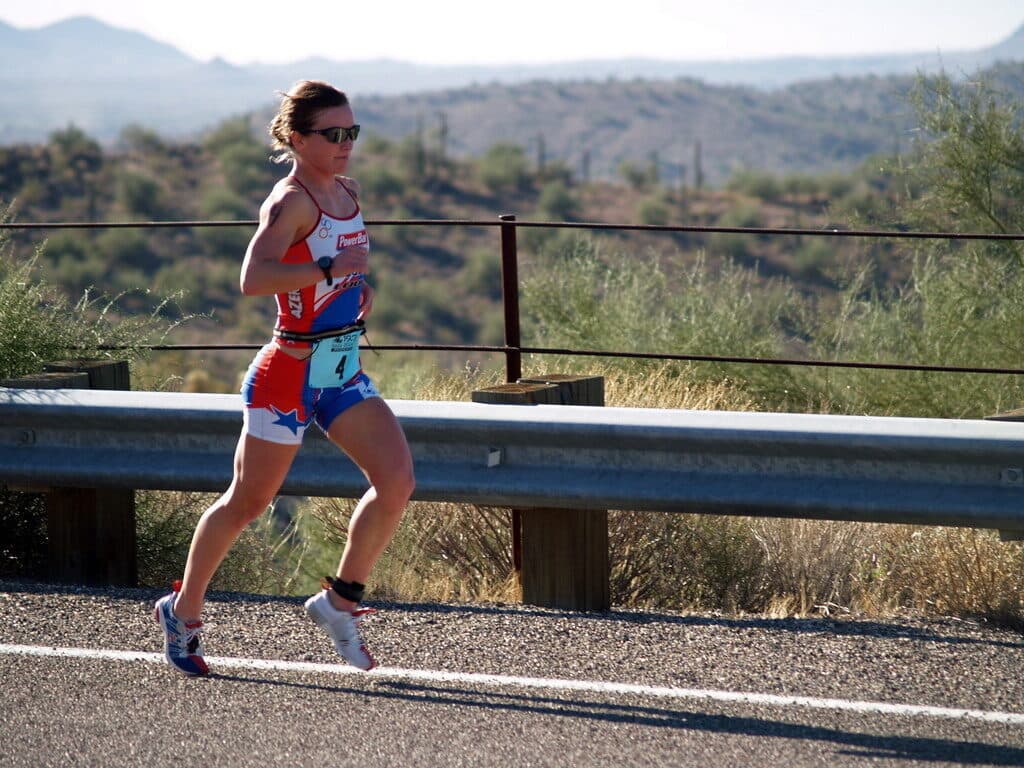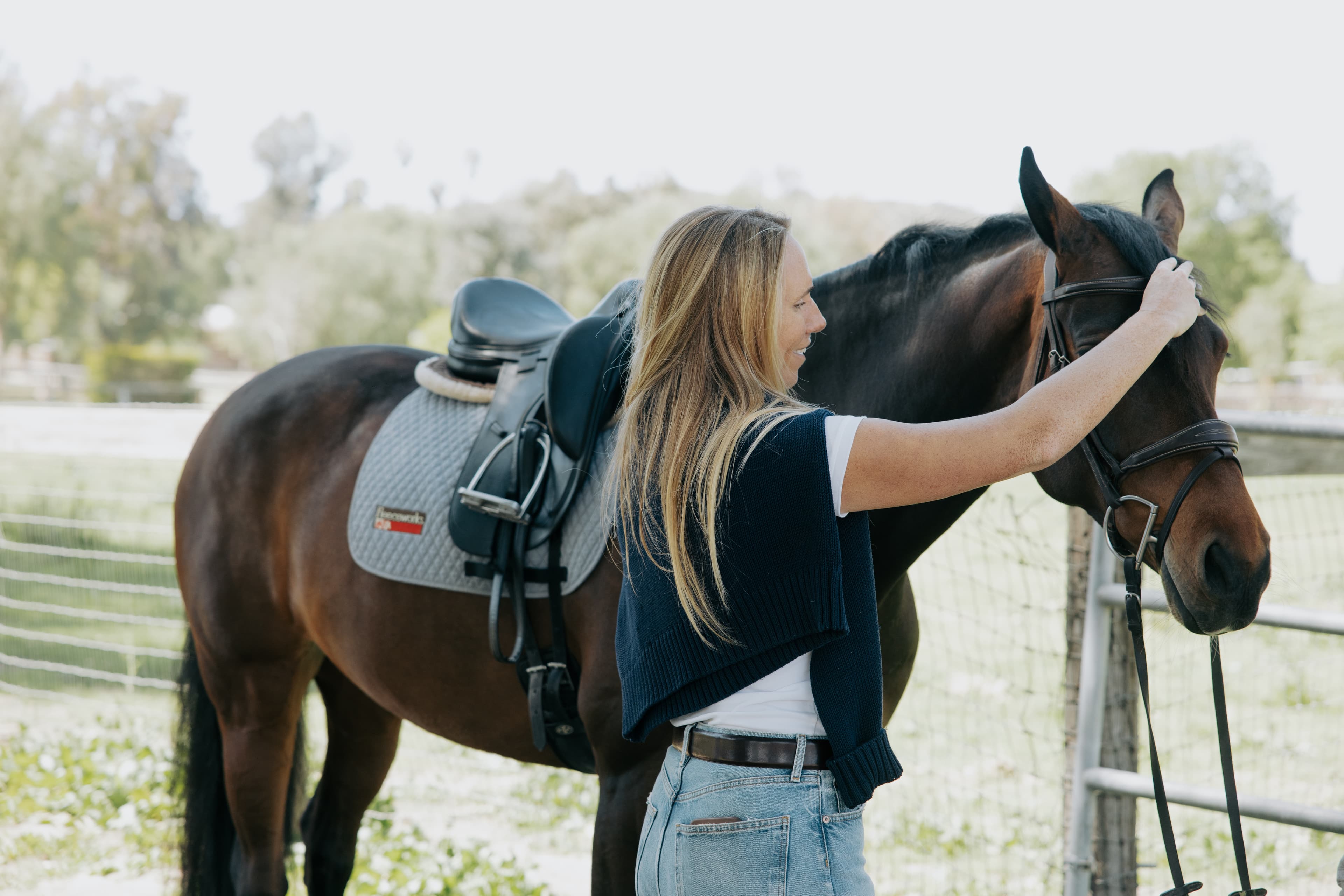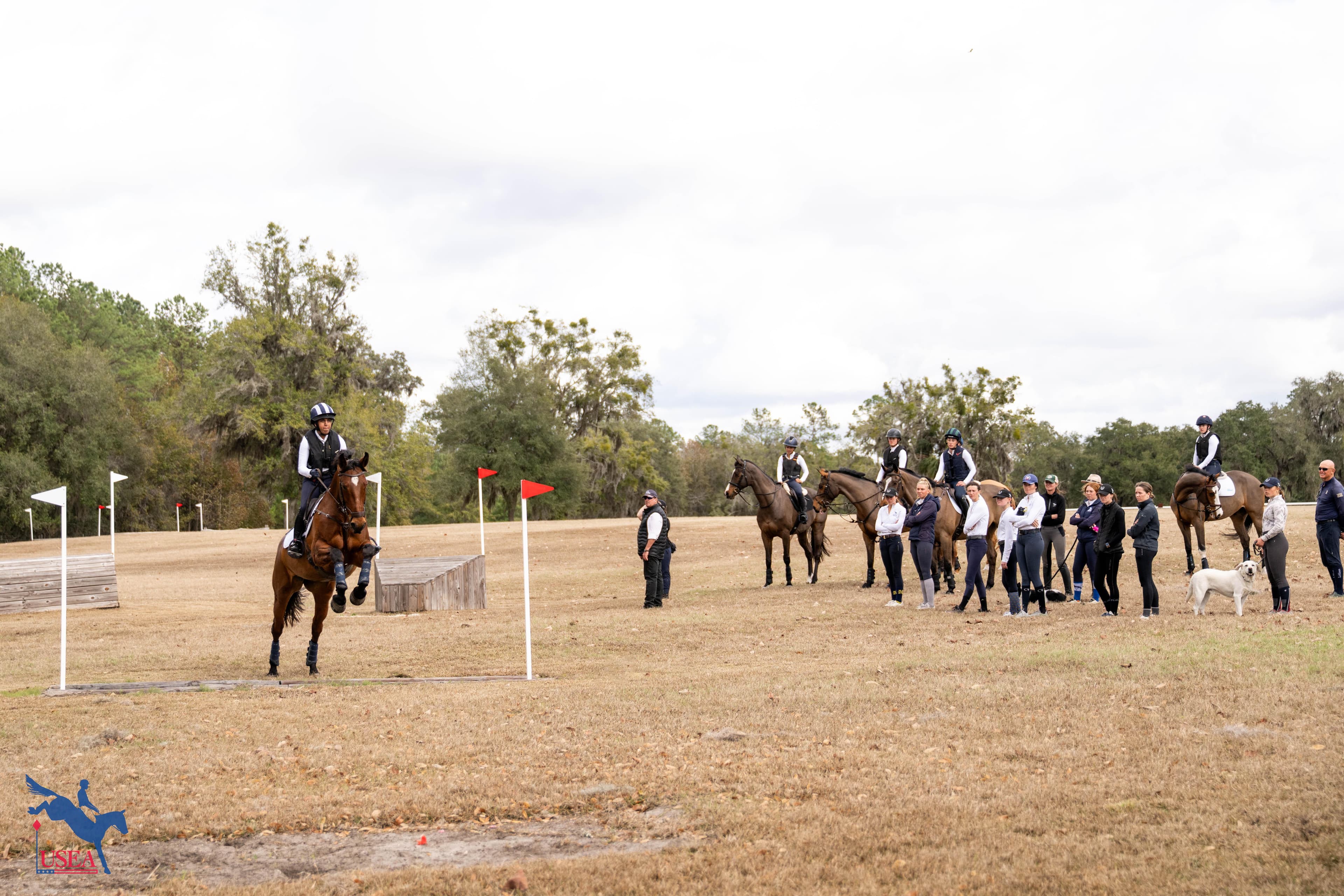Training Your Weaknesses with Courtenay Tuxhorn

A hunter/jumper rider in her youth, Courtenay Tuxhorn spent over a decade winning bike races, triathlons, and a marathon before finding her way back to the horse world in 2015 and to eventing in 2018. While she hasn’t raced since running the Boston Marathon six years ago, she maintains a fitness regimen that’s helped her and her horse find success in eventing. With a focus on efficiency, variety, and working independently, Courtenay’s approach to rider fitness is one that might fit many riders’ schedules as they juggle work, home life, riding their horse, and their own fitness.
Growing up, all I did physically was ride horses and hang out at the barn. It wasn’t really until I was an adult that I started working on my own physical fitness, in part because in my early working career I couldn’t afford having horses in my life, so I started running and riding bikes instead and things just grew from there. I learned a lot in my racing career – not the least of which was that I really missed riding horses! And when I found my way back into the saddle, I found that all I had learned while racing really helped me be a better equestrian athlete, too.
As an amateur rider with a full-time job, I find that the key to fitting everything in while also feeling successful is to make a fitness plan. I break down the core components of a fitness plan in a similar way to many of the other featured guests in this series: you have your cardio, your strength training, and your flexibility. You need all three, but how you structure them can take many forms. What works for me right now, in the buildup to my eventing season, is I do cardio three days a week, strength two to three days a week, and flexibility every day, in addition to riding my horse six days a week. Once competition season starts I will cut out one or two cardio or strength sessions, both to make sure I have enough time for everything and to make sure I feel rested and ready to go for my events.

In laying out your own fitness plan, it’s critical to start by knowing where your relative strengths and weaknesses are between cardio, strength training, and flexibility – and from there, make it a priority to train your weakness!
Cardio
For some riders, cardio is an overlooked weakness. That weakness means you feel tired by the end of cross-country and aren’t able to ride as well. For me, after all my years as an endurance athlete, cardio is definitely my strength. I do cardio regularly because I like it – I can happily join a masters swim practice and stare at the black line for 90 minutes, or throw on my sneakers and head out the door for two hours - I just like to go! But at this point my cardio fitness is plenty adequate to ride around a Training level cross-country course with no fatigue, so adding more cardio is not giving my riding any benefit. What’s more, it can feel detrimental to my riding if I get stiff and sore after a long hard cardio session – which, now that I am 41, is always a possibility!
My preferred cardio is walking for 45 minutes before work, typically three times a week. I like either a hill interval workout or a slow build workout, both of which get my heart rate up into the 140s/low zone two with less impact on my body than running, and it’s much quicker to prep for than something like swimming or biking or cross-country skiing. I can do this on a treadmill at a nearby gym, or just walking out my door and targeting a hill that’s a few blocks away.
Strength Training
Strength training for me consists of core workouts and a sport that you may not usually associate with horses.
In addition to riding, I am also a rock climber, and climbing constitutes most of my strength workouts. I picked it up when I stopped racing. It’s definitely my second priority sport after riding, but I really enjoy it. It’s something my husband and I do together, and I find that it complements riding well. You have to be very aware of your body position and how you are moving, you have to be strong, and it requires quick reactions and reflexes while also being very smooth and precise. As you might imagine, all of this translates well into the subtleties of your position and movements while riding – and for reacting well when things go a little sideways.

I really like that other riders featured in this series have also highlighted activities that promote coordination and body awareness – including Matt Brown with his martial arts practice and Tyler Held with Jiu Jitsu and Crossfit. If you don’t currently incorporate a sport that promotes body awareness into your fitness plan, consider trying one!
My strength routine consists of two weekly climbing sessions of about two hours each – one on the weekday that I give my horse the day off, and one on a weekend day after riding – plus one early morning climbing-specific training session such as a pullup routine or forearm training at home. If I have a busy week or an event over the weekend though, I will drop one of these strength sessions.
I also do a 15-minute core workout twice a week of primarily plank-based exercises, which I find translate well to a strong upper body position in the saddle. You can see some of my favorites here.
Flexibility (& Mobility)
Flexibility is definitely my weakness! That’s why I practice it every day. Weakness in this area translates into stiffness in the saddle as well as imbalance, neither of which are good for my horse, so I prioritize working on it.
I also include ‘mobility’ in this category, which anyone who has had a bad fall or any orthopedic surgeries might also want to do as well. I had some issues in my right hip which forced the end of my racing career, so now I see a bodyworker and a physiotherapist regularly and have a set of exercises I do daily to promote proper joint mobility in that hip. Yoga, pilates, etc. won’t do the trick if you have a poorly functioning joint, so you need to address joint mobility on its own.
In addition to my daily mobility exercises, I spend at least 15 minutes a day on the foam roller or stretching. I also do a flexibility routine at least twice a week at home. I have a couple of YouTube routines that I cycle in and out depending on how I’m feeling. Sometimes I’m in a yoga phase – my favorite is this 30 minute video that’s marketed to climbers but is not climbing-specific. I also love Foundation Training, a movement and stretching technique targeting the posterior chain, which along with your core is a key component to a strong upper body position while riding. Here is my go-to Foundation workout which is a very manageable 12 minutes long and it’s amazing, and here is a video that introduces some of the movements.
Fitness Tips
Here are some of my favorite tips for riders looking to start, revamp, or make marginal changes to their fitness regimens:

- Keep your workout time dedicated to your workout as much as you can. Multitasking – e.g. walking the dog while you do your workout walk – doesn’t usually produce a good result for your fitness nor for your dog’s enjoyment!
- If you’re taking up running for the first time or for the first time in a long while, remember to let your body get used to the impact. I’ve known a lot of fit people go out and run 30 minutes twice in a week after not running for a long time, and then not run again because they gave themselves shin splints, something in their knee feels funny, they feel sore all over, and so on. Start with something that seems overly short, like nine or 10 minutes three times a week, then build up by 10 percent a week in total volume until you get to 30 or 40 minutes per run, and your body will thank you.
- Speaking of getting hurt . . . my general rule is if something in my body hurts while I am doing an exercise, that’s bad and I stop doing the exercise. If I hurt afterwards, it’s not necessarily bad (it could be that I am just sore from using new muscles), but I pay attention to form the next time I do the exercise and how sore I am afterwards – the body adapts pretty quickly and should be a lot less sore after the second time doing something new compared to the first time provided you are on top of your nutrition and hydration.
- When doing a cardio workout alone, have a plan for the entire time you’ll be working out. Break it into sections by time with a goal and plan for each section. This is especially helpful for indoor workouts. “Five-minute warmup at 3.5 mph and 2 percent incline, five minutes at 4 mph and 2 percent incline, 3 x 7.5 minutes at 4 mph and 8 percent incline with 2.5 minutes recovery at 2 percent incline after each, five-minute cool down at 2 percent incline decreasing .1 mph each minute” goes by so much faster (and often more productively) than “walk on the treadmill for 45 mins.”
- If your regimen has been the same for a couple of months, switch it up! A successful fitness plan is one that blends variety with consistency. We need to exercise consistently to help our bodies be physically ready for the challenges of competing, but doing the same thing over and over just makes our bodies very good at doing that one thing. That’s one reason why classes like CrossFit and OrangeTheory can be so successful, they mix things up for you. I have never really been a ‘class’ person though, so I incorporate variety into my training on my own by adding intensity, changing the duration of intensity, changing up my core exercise routine, trying new exercises, switching from sport climbing to bouldering in my climbing workouts, etc.
- My home workout staples include: a foam roller, a yoga mat, a variety of resistance bands, a TRX, an ab roller, and a pull-up bar.
- Finally: remember to train your weakness! Don’t let the thing that’s weakest in your fitness routine haunt you while you’re out on course. Identify it, come up with a plan, and turn that weakness into a strength.
If you have a unique fitness routine, the USEA wants to hear from you! Email Jessica Duffy at [email protected] with your fitness routines, stories, or advice. To read other articles about rider fitness, click here.














